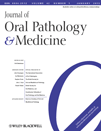Salivary gland hypofunction induced by activation of innate immunity is dependent on type I interferon signaling
Abstract
Background: Activation of innate immunity through polyinosinic:polycytidylic acid [poly(I:C)] causes acute salivary gland hypofunction. As a major consequence of poly(I:C) treatment is type I interferon (IFN) production, this study was undertaken to investigate their role in salivary gland dysfunction.
Methods: Different strains of mice deficient in either interferon alpha receptor (IFNAR1−/−) or IL-6−/−, or IL-10−/−, or EBI3−/− were treated with poly(I:C). Salivary gland function was determined by measuring pilocarpine-induced saliva volume. Gene expression levels were measured by real-time PCR. Ca2+ mobilization studies were performed using ex-vivo acinar cells.
Results: A single injection of poly(I:C) rapidly induced salivary gland hypofunction in wild-type B6 mice (41% drop in saliva volumes compared to PBS-treated mice). In contrast, the loss of function in poly(I:C)-treated IFNAR−/− mice was only 9.6%. Gene expression analysis showed reduced levels of Il-6, Il-10, and Il-27 in submandibular glands of poly(I:C)-treated IFNAR−/− mice. While salivary gland dysfunction in poly(I:C)-treated IL-10−/− and EBI3−/− mice was comparable to wild-type mice, the IL-6−/− mice were more resistant, with only a 21% drop in function. Pilocarpine-induced Ca2+ flux was significantly suppressed in acinar cells obtained from poly(I:C)-treated wild-type mice.
Conclusions: Our data demonstrate that a combined action of type I IFNs and IL-6 contributes toward salivary gland hypofunction. This happens through interference with Ca2+ mobilization within acinar cells. Thus, in acute viral infections and diseases like Sjögren’s syndrome, elevated levels of type I IFNs and IL-6 can directly affect glandular function.




